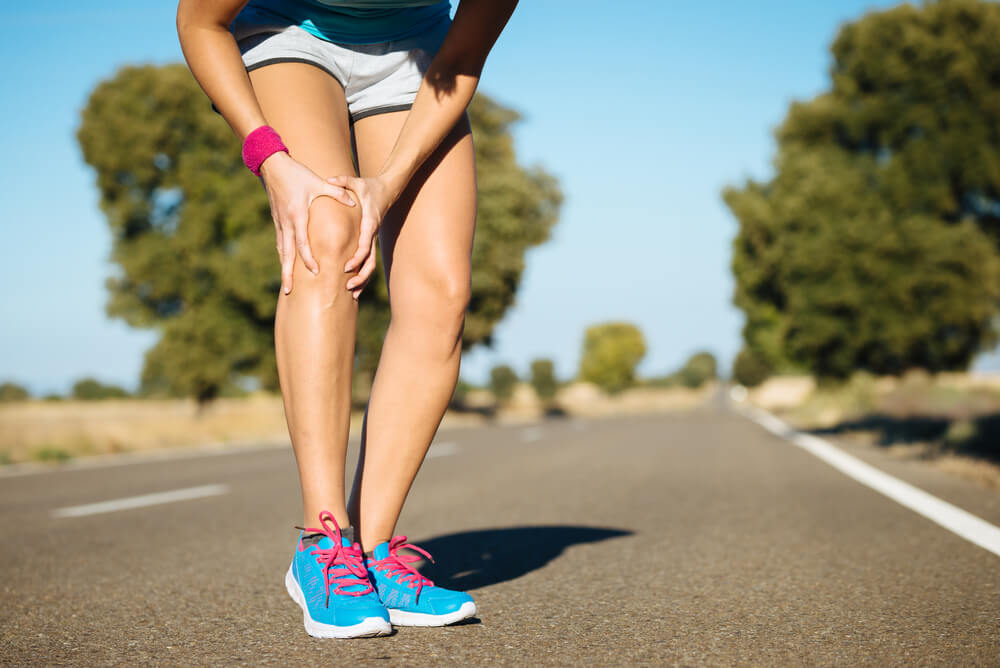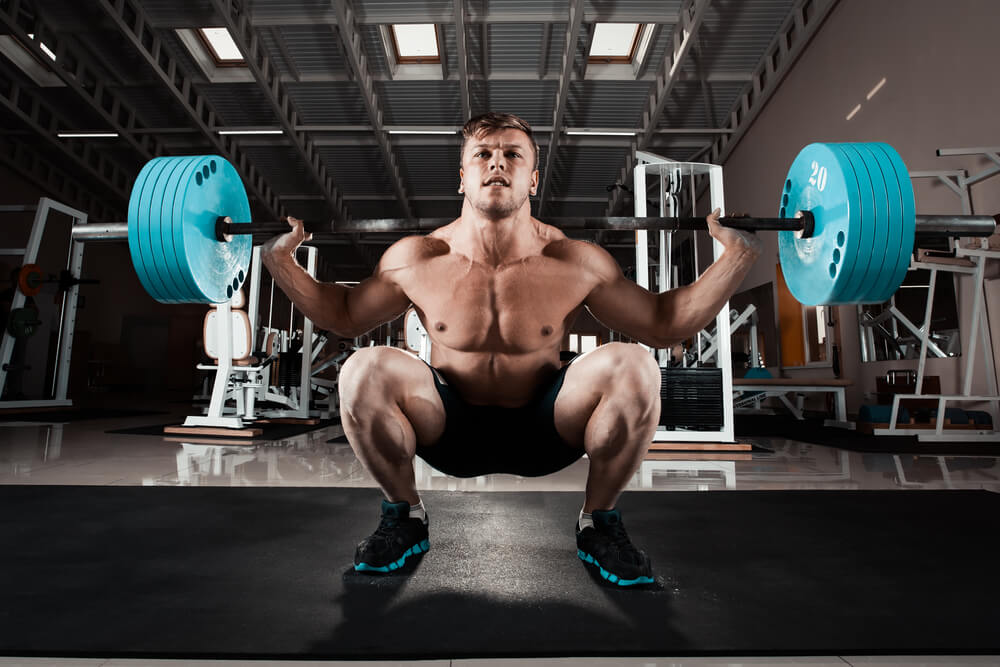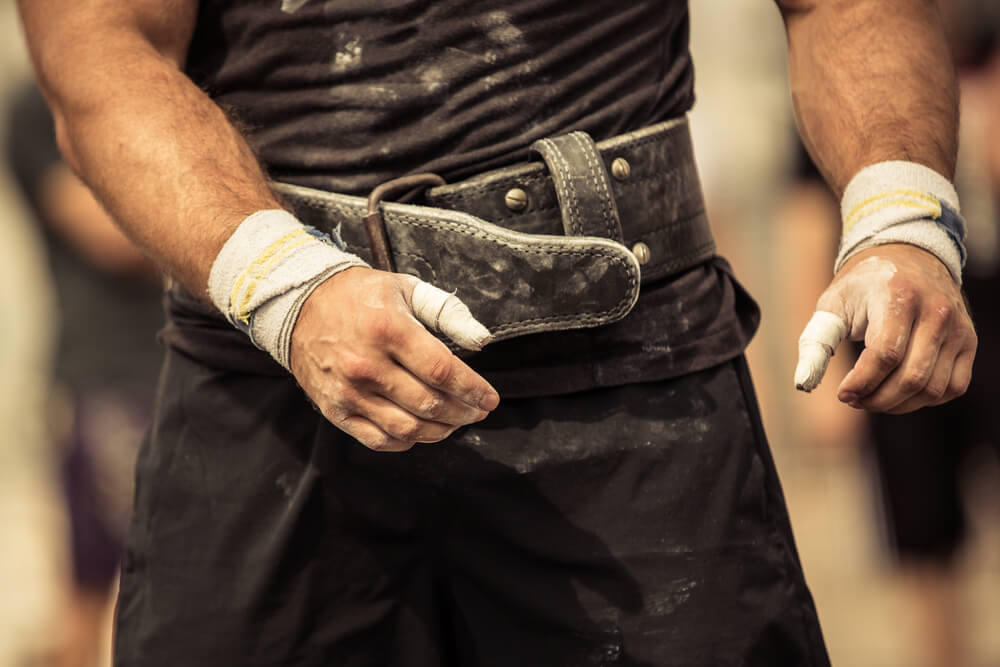
Do you suffer from knee pain as a result of doing squats? You shouldn’t. We explain why that shouldn’t happen and give you tips to help you ensure it doesn’t continue.
The squat exercise is the most popular exercise being performed. The deadlift is right behind it. However, with popularity comes improper performance because people often want to impress more than they want progress. This is becoming a big problem. Why? Knee pains tend to come from using improper form.
You may see people say in social media posts that they had an amazing leg-training day. They back it up by adding that their knees are sore. But this is not a muscle region that you target. Your knees are joints. They should not experience any pain during the movement. Let’s take a look at form mistakes and give you tips to correct them while also preventing knee damage.

Don’t Point Your Toes Forward During Squats
It seems that some people believe they can squat more efficiently with their toes pointed forward. The issue with this is that it’s likely the easiest way to blow out your knees, assuming you do your squats this way enough times. Plus there is nothing natural about this position.
A good example to consider is how toddlers squat. Nearly every toddler performs a perfect squat without even knowing that they did. One part of the perfect squat is having your toes pointed 30 to 45 degrees off center.
Why?
This allows you to squat down with your toes aligned with your knees, and your knees aligned with your hips. The alignments are what allow you to drop your hips for a nice deep squat. This is going to enable better gains in both muscle and strength. Plus you are allowing your knee joints to open properly.
On the other hand, when you squat with your feet forward, it’s a different outcome for most. Take a second and actually give it a try. Stand with your feet shoulder-width apart and toes pointed forward. Now squat down and see how far you get.
Most will only reach the half squat position instead of being able to perform a full squat. Half squats are good for vertical jump improvement but other than that they are useless.
Why?
Your femur bone is literally trying to push its way forward as you place the pressure down on your knee joints to get out of the squat position.
Always think toes aligned with your hips. Never perform heavy resistance squats with your toes pointed forward. Not only does it cause knee pains during squats, but it can also make you lose your balance.
Don’t Push Off With The Front Of Your Feet
This is likely the most common reason you experience knee pains during squats. It’s true that it seems like such a small detail. But when you place twice your body’s weight on your shoulders it makes a huge difference.
Let’s use the toddler example again. When toddlers squat they not only have their feet angled out, but they also have their feet firmly planted on the floor. Over time we develop a habit of squatting down on our toes. This causes the bad habit of pushing off with our toes as well. Doing so will put a lot of strain on your knees instead of allowing the force to be held on the middle and heels of your feet.
The easiest way you can solve this issue is by practicing without any resistance and just doing air squats (like bodyweight squats). Get used to the rhythm of never pushing off with the front of your feet. After you feel comfortable, slowly add resistance and see how well you still perform the squat.
Usually, younger adults will get away with this improper execution of the squat.
Why?
Their body is still young and their bones are strong enough to get away with it. But over time, the force weakens your knees and pains begin to arise. This inflammation will be pretty noticeable. And, no, the pain does not mean you are getting a good pump in.
Don’t Allow Your Knees To Bow In
What this means is that your knees begin to bend inwards instead of remaining aligned with your hips. This is unnatural and places sheer force that in time will not only result in knee pains, but is also an easy way to suffer a bad training injury. But how does this even happen?
It doesn’t sound possible, but this occurs when you are trying to use your knees to help with the lift after you have went into the squat. This is another form issue that can be resolved by ensuring that you always push off with your mid-foot and heels while also driving your hips back up. If your knees are forced into bowing in, then you need to lower the weight being used and try again.
Some Say Don’t Allow Your Knees To Go Past Your Toes
There are some who claim that squatting and allowing your knees to go past your toes will cause knee pains. This is not a bad observation since it does truly seem to be a reason. The thing is that sometimes it may be multiple things that make it appear to look like it’s the cause.
For example, powerlifters squat down and always have their knees go past their feet. When they were told to not allow their knees to go past their toes, they just couldn’t do it. They needed an actual physical device to tell them when to stop the squat, which usually ended a little before hitting below parallel.
So this is most likely a myth. It’s easy to conclude that after a couple of studies looked into it and there’s been nothing said to support the theory. Plus we have real life models to look at. These powerlifters squat 800 pounds using this method and seem to do no harm to their knees.
Squats Are Bad For You Myth
Any time something bad happens too often during an exercise, the fitness world seems to deem it unsafe for your health. But it is not the exercise that is unhealthy. Rather, it is the way it’s being performed by the athlete that is unhealthy.
Knee pains are common with squats and most already know this. However, as noted, the knee pains derive from issues such as foot placement and force distribution. Fixing them makes the pains go away, and that makes the exercise safe again.
We also have to take into account that squats are a functional exercise. That means that doing them strengthens your body to perform a common daily movement. When people pick up a heavy box from the floor, they are told to bend at the hips instead of their back.
This concept is basically saying squat down and let your legs push up the weight. They are naturally the strongest spot. Unless a doctor has told you otherwise, you should be doing squats on a routine basis (at least once a week).
Extra Tips To Help Your Squats
No matter what, if your form is not right these tips will not solve the pains you feel in your knees. However, after spending time practicing your form, you can start to focus on the finer details.
Wear Flat Shoes With Little Cushion
You want your feet as close to the floor as you can get them to achieve the most from your squat. This allows you to get that more effective push off without using the front of your feet.
People even like to squat without shoes on at all. That is about as perfect as you can get. The issue with that is safety. As a result, most gyms will not allow you to do this. A good type of shoe to use is a regular Chuck Taylor. But there are also performance shoes specifically designed for squats and deadlifts.
Wear Knee Sleeves
Knee sleeves are generally for when you plan on lifting heavy, but they can come in handy with helping your movements, regardless of the weight being used. The purpose behind them is to create compression against your knee joints to prevent pains from occurring under pressure.
Some people even wear them just to have a better sense of where their body is during the squat. This is about timing and knowing your equipment. They are usually cheap unless you choose a big name brand.
Wear A Lifting Belt
Lifting belts come in handy when it comes to keeping pressure off of your lower spine during the squat. They are also intended to help keep your back straight. A rounded back is a surefire way to lower back pains unless you are an experienced powerlifter who knows how to squat this way and can get away with it.
The type of weight lifting belt depends on what makes you feel comfortable. Most use the ones that have a wide middle piece to cover almost all the lower back region. There are others that use a slimmer version that are about 50% smaller in width. Also, note there is either Velcro or traditional belt holes. The Velcro may not be a good idea because it easily gets worn down.
Don’t Forget To Warm Up!
One of the easiest ways to prevent injuries during the squat is by doing a proper warm up. Usually five minutes is enough time to help get your tight muscles loose and have your joints ready to move in their fullest range of motion. Active stretching is the best for this.
Why?
These types of stretches put your body into motion. Some examples of this stretching are butt kicks, pendulum swings, and high knees.
Static stretching is different and is not recommended for the warm up. Studies show static stretching actually decreases muscle strength and can cause your performance to suffer.
Static stretches are the ones where you pull a joint into its max range of motion and hold the position for around 30 seconds. They are great for intro and post workout, but they are just not ideal for warm up purposes.
One of the simplest ways to warm up for squats is to actually perform them. There is really no better way to get your joints and muscles ready than to just do the movement. If you’re doing barbell squats, then you should do squats with a barbell and no extra weight. This not only helps prevent pains and injuries but also boosts your ability to squat more weight and/or do more reps.
Conclusion
When performed correctly, the squat exercise is one of the best ones for strength and functional training. People even like this exercise being implemented into a circuit-training program where they can burn fat as well. Plus there are many different positions you can perform squats.
Remember, the most important factor for the squat is form. There are four simple tips to use every time you get into position, regardless of how much weight you plan to lift. First, stand with your feet shoulder-width apart. Second, angle your toes 30 to 45 degrees away from center. Always ensure your back is straight and not hunched. Finally, your chest should be out and chin tilted up.
These four tips will ensure that you perform squats correctly. Always make a point of going through these four tips in your head prior to lifting until you have done it enough times that you can get into the proper stance without thinking about it.
Squats are great. The only real problems arise when you do not use proper form. Don’t make that mistake. If you can stick to proper form, you should be able to reap all the many benefits of squats without getting pain.
By Brian Pankau, CPT
Latest posts by Terry M (see all)
- Garage Gyms - Aug 1, 2018
- Kettlebells – Why They Should Be Added To Your Routine. - Jul 24, 2018
- Weight Belts: What Are They Really For? - May 31, 2018













[…] This procedure gained attention when Kobe Bryant visited Germany to receive PRP treatments for a series of knee injuries. […]